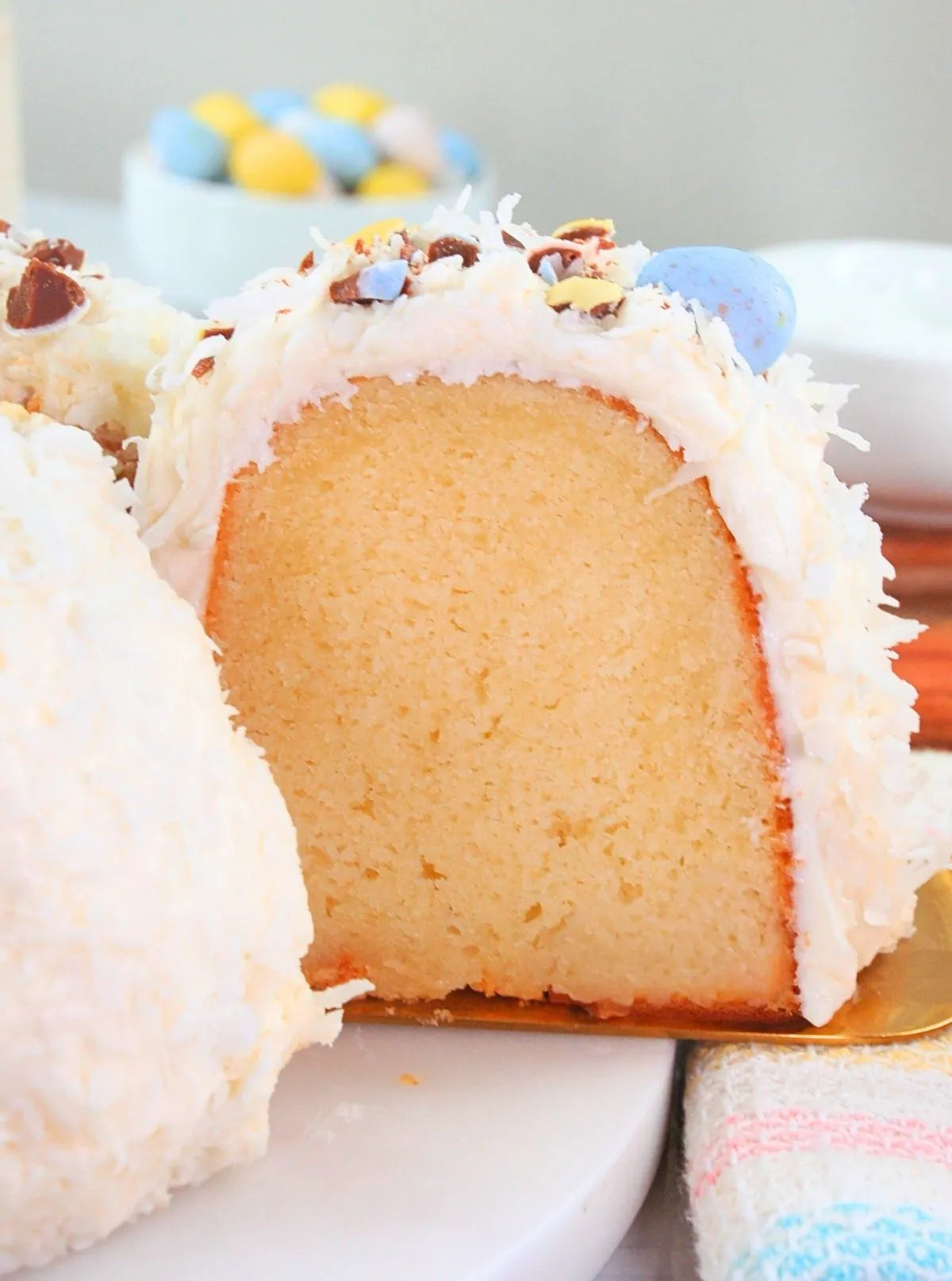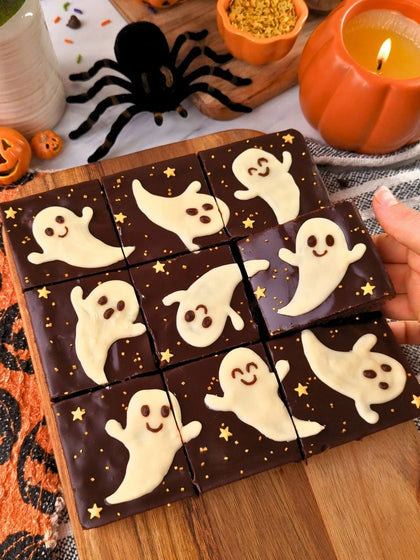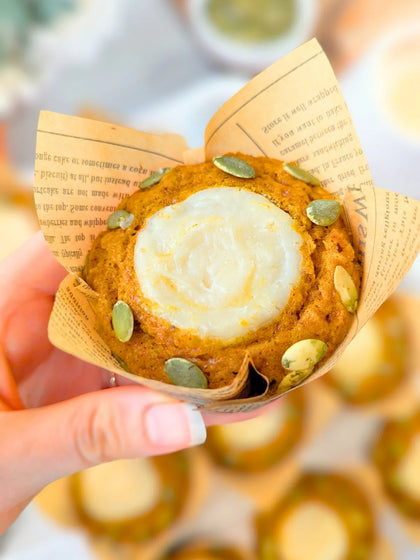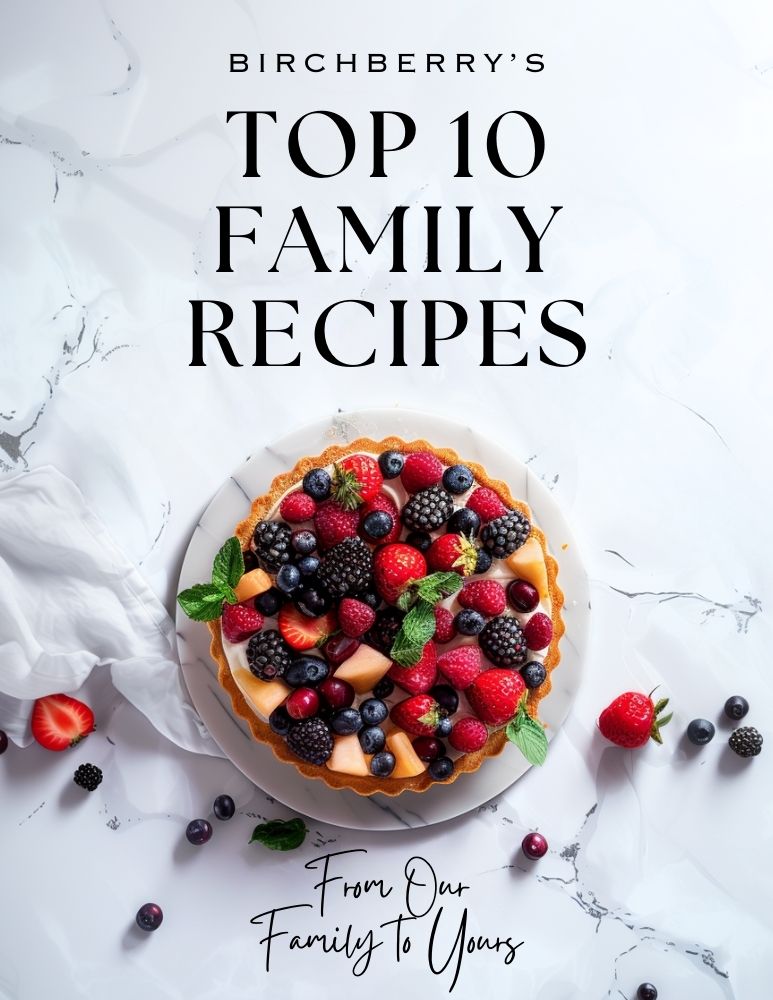Easter Coconut Bundt Cake
Servings
16-24
Prep Time
20 minutes
Bake Time
1 hour

This Coconut Bundt Cake is moist, velvety, and full of rich coconut flavor from creamy white chocolate and coconut milk. It’s topped with fluffy coconut cream cheese frosting and sweet shredded coconut, a copycat of the famous Doan’s Bakery coconut bundt cake (Tom Cruise’s favorite!). We hope you have as much fun making this as we do!








Ingredients
- 360 g (3 cups) cake flour, spooned and leveled
- 10 g (2 tsp) baking powder
- 9 g (1½ tsp) kosher salt
-
240 ml (1 cup) canned full-fat coconut milk, room temperature (whisked well)
- 170 g (6 oz) white chocolate, finely chopped bar or chips (must have cocoa butter)
- 180 g (¾ cup) sour cream, room temperature
- 30 ml (2 Tbsp) neutral oil (canola or vegetable)
- 18 g (1½ Tbsp) coconut emulsion (or extract)
- 5 g (1 tsp) vanilla extract
- 226 g (2 sticks / 1 cup) unsalted butter, softened (65–70°F)
- 450 g (2¼ cups) granulated sugar
- 5 large eggs, room temperature
-
170 g (¾ cup / 1½ sticks) unsalted butter, room temp (68–72°F)
-
170 g (¾ brick / 6 oz) full-fat cream cheese, room temp (68–72°F)
-
270–360 g (2¼–3 cups) powdered sugar, sifted (see notes)
-
30 g (2 Tbsp) canned full-fat coconut milk, room temperature (whisked well)
-
8 g (1½ tsp) coconut emulsion (or extract)
-
3 g (½ tsp) vanilla extract
-
⅛ tsp salt (increase to ¼ tsp if using unsalted butter)
- 160 g (2 cups) sweetened shredded coconut, for coating
- 100 g (about ½ cup) Cadbury Mini Eggs, whole and roughly chopped (optional)
Coconut Cake
Coconut Cream Cheese Frosting
Topping
Instructions
Coconut Cake
Preheat oven to 325°F and position the rack in the middle. Grease and flour a 12 to 15-cup Bundt pan or use baking spray with flour.
- In a microwave-safe bowl, combine coconut milk and white chocolate. Microwave for 30 seconds, then in 10-second increments, whisking after each, until melted and smooth. Let cool to room temperature (85–95°F max).
- In a large measuring cup or small bowl, whisk together the cooled coconut milk mixture, sour cream, oil, coconut emulsion, and vanilla extract until smooth, about 30 seconds. Set aside.
- In a medium bowl, whisk together the flour, baking powder, and salt vigorously for 30 seconds. Set aside.
- In a stand mixer fitted with the paddle attachment, beat the butter on medium speed until smooth, about 1 minute.
- With the mixer on medium-high, gradually add the sugar, beating for 3–4 minutes until light and fluffy, scraping the bowl as needed.
- Add eggs one at a time, mixing on low for 15–20 seconds after each, scraping after every two. Mix the final egg on low for 30 seconds to fully incorporate.
- With the mixer on low, gradually add dry ingredients in three parts each and slowly pour wet ingredients in two, alternating between them and beginning and ending with the dry. Mix 20–30 seconds after each addition until just combined. Scrape as needed.
- Finish the batter by folding with a spatula to ensure it’s smooth and no flour pockets remain.
Pour batter into the prepared Bundt pan, filling it about ⅔–¾ full or 2” from the top.
- Smooth the top with a spatula into all the crevices, then gently tap the pan on the counter twice to release any air bubbles.
- Bake for 55–65 minutes, checking at 50. A skewer inserted into the center should come out mostly clean with a few moist crumbs. Tent loosely with foil if the top is browning too quickly.
- Let the cake cool in the pan for 15 minutes, then carefully invert onto a wire rack. Cool completely before frosting, about 3 hours.
Coconut Cream Cheese Frosting
In a stand mixer fitted with the paddle attachment, beat the butter and cream cheese on medium speed for 2–3 minutes until smooth and fluffy, scraping the bowl as needed.
Add the powdered sugar in two batches. Mix on low for 30–40 seconds after each addition until just combined, then beat on medium for 1–2 minutes until creamy. (see notes on sweetness)
- Add the coconut milk, coconut emulsion, vanilla, and salt. Beat on medium for another 1–2 minutes until fluffy, scraping the bowl once halfway through.
Assembly
Once the cake is fully cooled, use an offset spatula to spread a thick, even layer of frosting over the top and sides, covering the inner ring as well.
- Sprinkle the shredded coconut generously over the frosted cake, pressing lightly to help it adhere.
- Top with whole and chopped Mini Eggs, if using.
- Let the frosting set for 15–20 minutes, then slice and serve at room temperature.
This post may contain affiliate links.
Notes
- Servings: One 12–15 cup Bundt cake (about 16–24 servings).
- Storage: Store unfrosted cake tightly sealed at room temperature for 1-2 days. Store frosted cake covered at room temperature for up to 4 hours or in the fridge for 3–4 days. Bring to room temp before serving. Freeze unfrosted cake for up to 3 months.
- Before You Bake: Bundt cakes can be a little finicky due to the amount of batter and long bake time. It may take a few tries to get a feel for the timing, your oven’s behavior, and when to pull it out. We’ve included exact mixing times to help—keep a timer handy while you mix. A skewer test is the best way to check for doneness here. I usually give an internal temp, but for Bundts, it’s too inconsistent.
- Bundt Pan: Use a light-colored, heavy cast aluminum pan. This Nordic Ware Bundt Pan changed our lives.
- Cake Flour: Cake flour is essential. Its lower protein content creates less gluten, giving you a softer, more delicate crumb. All-purpose flour can make the cake heavier and increase the chance of gummy streaks. Don’t use the cornstarch substitute for this one, it won’t yield the same results.
- Coconut Emulsion: For flavored cakes and frostings, we always recommend using an emulsion. They're water-based instead of alcohol-based like extracts, so the flavor comes through stronger and holds up better in high heat.
- White Chocolate: Use high-quality white chocolate that contains cocoa butter—avoid chips, which often have stabilizers. Cool the melted chocolate until it’s just warm to the touch before adding to the batter to avoid cooking the eggs.
- Mixer: A hand mixer works in place of the stand mixer, but a whisk won’t work well for this recipe.
- Don’t Overfill Pan: Ensure there is at least 2 inches from the batter to the top of the pan.
- When to Flip: After cooling in the pan, gently press the top—if it springs back without sticking, it’s ready. You can also tap the pan; if it sounds hollow and doesn’t jiggle, you’re good to go.
- How to Flip: Place a wire rack over the pan, grip both sides, and invert. If properly greased and rested, it should pop right out.
- Frosting Texture: Butter and cream cheese should be the same temp (65–68°F) for a smooth mix. If it looks greasy or separated, chill for 20 minutes, then beat in ½–1 cup sifted powdered sugar until smooth.
- Frosting Sweetness: For a less sweet frosting, start with 270g (2¼ cups) powdered sugar. If desired, add the remaining powdered sugar 30g (¼ cup) at a time until you reach your desired sweetness. This recipe uses salted butter - if using unsalted, you’ll need to increase your salt quantity by at least ⅛ tsp more.
- Gummy or Gluey Streaks: We’ve all been there -your cake looks perfect on the outside, but when you slice in, it’s a gluey mess. These “sad streaks” can happen for several (often contradictory) reasons. Over-creaming butter and sugar is the most common. But it can also be from oven temperature fluctuations, overbaking or underbaking, cooling too long in the pan, or even overmixing after the flour is added. Too much liquid, too little sugar, or too much sugar. Use a scale for accuracy and don’t be too hard on yourself - the flavor is still usually great!
- Flaky Bottom: If the cake’s bottom separates, it could be from overmixing the eggs. Add each egg just until combined - once the yolk streaks are gone, move on to the next. Overbeating adds too much air and can cause that bottom layer to lift and separate in the oven. It often settles as it cools, but for a picture-perfect cake, go easy on the eggs.
- Cake Flavor: Best made ahead! Let the unfrosted cake sit, tightly covered, for a few hours or overnight to deepen the coconut flavor and moisture.
- Oven Temperature: A lower oven temp ensures even baking, prevents over-browning before the center is done, and encourages a smooth rise without doming or cracks. We use an oven thermometer to monitor throughout the bake.
Happy baking! ❤️
Emma & Eric
Just Pre-Launched!
Make your bakes easier and more fun with our premium Adjustable Rolling Pin.
Shop Now@birchberryco Coconut Bundt Cake 🌼🐣🤍🌸 Full recipe is on our website, Birchberryco.com. Our first product is launching in the U.S. in 2025! Sign up for our email list to get updates and be the first in line! #easter #coconutcake #cake #bundtcake #baking #easterbaking #dessert #bakingrecipe #bakingtherapy #baketok #bakingtiktok #aesthetic #cottagecore #asmr ♬ original sound - LYN








